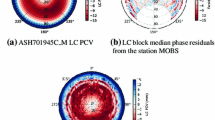Abstract
When neglecting calibration issues, the accuracy of GPS-based time and frequency transfer using a combined analysis of code and carrier phase measurements highly depends on the noise of the GPS codes. In particular, the pseudorange noise is responsible for day-boundary discontinuities which can reach more than 1 ns in the time transfer results obtained from geodetic analysis. These discontinuities are caused by the fact that the data are analyzed in daily data batches where the absolute clock offset is determined by the mean code value during the daily data batch. This pseudorange noise is not a white noise, in particular due to multipath and variations of instrumental delays. In this paper, the pseudorange noise behavior is characterized in order to improve the understanding of the origin of the large day-boundary discontinuities in the geodetic time transfer results. In a first step, the effect of short-term noise and multipath is estimated, and shown to be responsible for only a maximum of 150 ps (picoseconds) of the day-boundary jumps, with only one exception at NRC1 where the correction provides a jump reduction of 300 ps. In a second step, a combination of time transfer results obtained with pseudoranges only and geodetic time transfer results is used to characterize the long-term evolution of pseudorange errors. It demonstrates that the day-boundary jumps, especially those of large amplitude, can be explained by an instrumental effect imposing a common behavior on all the satellite pseudoranges. Using known influences as temperature variations at ALGO or cable damages at HOB2, it is shown that the approach developed in this study can be used to look for the origin of the day-boundary discontinuities in other stations.









Similar content being viewed by others
References
Allan DW, Thomas C (1994) Technical directives for standardization of GPS time receiver software. Metrologia 31:69–79
Bruyninx C, Defraigne P (2000) Frequency transfer using GPS codes and phases: short and long term stability. In: Breakiron LA (ed) Proceedings of the 31st PTTI meeting, Dana Point, California, December 1999, pp 471–478
Bruyninx C, Defraigne P, Sleewaegen JM, Pâquet P (1999) Frequency transfer using GPS: a comparative study of code and carrier phase analysis results. In: Breakiron LA (ed) Proceedings of the 30th PTTI meeting, Reston, Virginia, December 1998, pp 307–314
Defraigne P, Petit G (2003) Time transfer to TAI using geodetic receivers. Metrologia 40:184–188
Dunn C, Lichten S, Jefferson D, Border JS (1991) Sub-nanosecond clock synchronization and precision deep space tracking. In: Proceedings of the 23rd precise time and time interval meeting, NASA Conference Publications, vol 3159, pp 89–101
Elosegui P, Davis J, Jaldehag R, Johansson J, Niell A, Shapiro I (1995) Geodesy using the Global Positioning System: the effects of signal scattering on estimates of site positions. J Geophys Res 100:9921–9934
Estey LH, Meertens C (1999) TEQC: the multi-purpose toolkit for GPS-GLONASS data. GPS Solutions 3(1):42–49
Hugentobler U, Dach R, Fridez P, Meindl M (eds) (2004) Bernese GPS software version 5.0. Astronomical Institute University of Berne
Larson KM, Levine J, Nelson LM, Parker T (2000) Assessment of GPS carrier-phase stability for time-transfer applications. IEEE Trans Ultrason Ferroelect Freq Contr 47(2):484–494
Overney F, Schildknecht Th, Beutler G, Prost L, Feller U (1997) GPS time transfer using geodetic receivers: middle-term stability and temperature dependence of the signal delays In: Proceedings of the 11th European frequency and time forum, pp 504–508
Overney F, Prost L, Dudle G, Schildknecht Th, Beutler G, Davis JA, Furlong JM, Hetzel P (1998) GPS time transfer using geodetic receivers (GeTT): results on European baselines. In: Proceedings of the 12th EFTF, pp 94–99
Ray J, Senior K (2003) IGS/BIPM pilot project: GPS carrier phase for time/frequency transfer and time scale formation. Metrologia 40(3):S270–S288
Ray J, Senior K (2005) Geodetic techniques for time and frequency comparisons using GPS phase and code measurements. Metrologia 42(4):215–232
Schildknecht Th, Dudle G (2000) High precision using GPS phase measurements. GPS World 11(2):48–52
Schildknecht Th, Beutler G, Rotacher M (1990) Towards sub-nanosecond GPS time transfer using geodetic processing technique. In: Proceedings of the 4th European frequency and time forum, pp 335–346
Senior K, Ray J (2001) Accuracy and precision of carrier phase clock estimates. In: Proceedings of the 33rd precise time and time interval meeting, pp 199–217
Senior K, Ray J (2005) Using IGS clock products to monitor GPS station performance, IGS Mail #660. http://www.igscb.jpl.nasa.gov/mail/2004/msg00342.html. Cited 15 October 2005
Smolarski A, Lisowiec A, Nawrocki J (2002) Improving the accuracy of GPS time transfer by thermal stabilization of GPS antenna and receiver. In: Proceedings of the 16th European frequency and time forum, St Petersburg
Wübbena G, Schmitz M, Boettcher G (2006) Near-field effects on GNSS sites: analysis using absolute robot calibrations and procedures to determine corrections. In: Proceedings of the IGS workshop 2006, Darmstadt (in press)
Acknowledgments
We thank J.M. Sleewaegen for helpful discussions; Jim Ray and an anonymous reviewer are also acknowledged for their very constructive reviews of the paper.
Author information
Authors and Affiliations
Corresponding author
Rights and permissions
About this article
Cite this article
Defraigne, P., Bruyninx, C. On the link between GPS pseudorange noise and day-boundary discontinuities in geodetic time transfer solutions. GPS Solut 11, 239–249 (2007). https://doi.org/10.1007/s10291-007-0054-z
Received:
Accepted:
Published:
Issue Date:
DOI: https://doi.org/10.1007/s10291-007-0054-z




